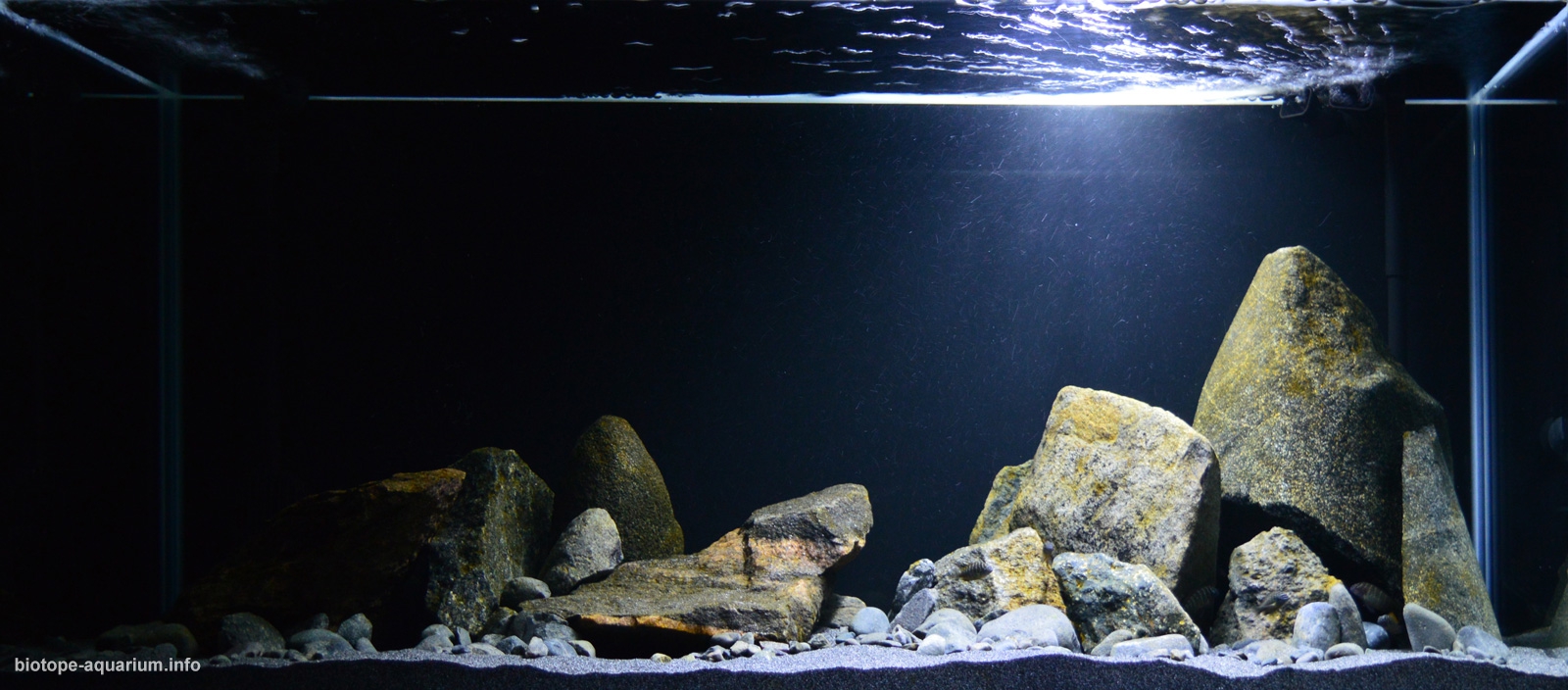Lake Tanganyika, East Africa, Tanzania, Kasanga
93rd place in Biotope Aquarium Design Contest 2018
![]() Lithuania. Inga Ragėnė
Lithuania. Inga Ragėnė

Volume: 390 L
Dimensions: 130x50x60 cm
List of fishes: Tropheus moorii “Kasanga”, Altolamprologus compressiceps
List of plants: N/A
Description of decorations: The rocks was collected from Lithuanian grasslands and meadows, streams and dams (about 110 kg). The sand is JBL Sansibar “Dark” (about 25 kg).
Description of equipment: Filtration: Fluval FX6 (2130 l/h) and Eheim 2275 Professionel 4+ 600 (1250 l/h). Lighting: 1 x 18W led tube Aqueael “PLANT” (1300 lm), 1 x 18W led tube Aquael “MARINE” (1600 lm), night lighting 1 x white led tube (48 cm long). Heating: Hydor 300W heater for external canister filters.
Water parameters: The Ph is 8,5 and the temperature is 26°C.
INFORMATION ABOUT BIOTOPE
Description of the area surrounding the biotope: Tanganyika is the largest rift lake in Africa and the second largest lake by volume in the world. It is the deepest lake in Africa and holds the greatest volume of fresh water, accounting for 18% of the world’s available fresh water. The lake Tanganyika is divided among four countries – Tanzania, Democratic Republic of the Congo (DRC), Burundi, and Zambia, with Tanzania (46%) and DRC (40%) possessing the majority of the lake. The water flows into the Congo River system and ultimately into the Atlantic Ocean.
Description of the underwater landscape of the biotope: Tropheus lives at rock and cobble shores where it inhabits a wide range of water depths, sometimes down to 40 m, but its highest density is between the depths of 0.5 and 5 m. The genus is highly specialized and occupies the trophic niche of mainly browsing on filamentous algae, whereas other genera utilize different resources in this complex littoral species community. In the littoral zone of freshwater lakes, several ecological factors vary strongly with water depth. Tropheus moorii prefers shallow water, presumably because of the higher algal productivity, warmer temperatures and lower mortality risk caused by pelagic predatory fish. Only very large adults tend to use slightly deeper water (>5 m). Looking at the records of the Kasanga area I noticed the more angular stones than in other regions.
Description of the parameters of the habitat: The lake’s water is alkaline with a pH of around 9 at depths of 0–100 m (0–330 ft). Below this it is around 8.7 Ph, gradually decreasing to 8.3—8.5 Ph in the deepest parts of Tanganyika. Surface temperatures generally range from about 24 °C (75 °F) in the southern part of the lake in early August to 28–29 °C (82–84 °F) in the late rainy season in March—April. At depths greater than 400 m (1,300 ft) the temperature is very stable at 23.1–23.4 °C (73.6–74.1 °F). The water has gradually warmed since the 1800s and this has accelerated with global warming since the 1950s.
List of fishes: The lake contains at least 250 species of cichlid fish (Cichlidae) and 150 other species of non-cichlid fish, most of which live on the shore of the lake, at a depth of 180 m. The lake is also an important site of study on the evolution of species. Almost all (98%) of the cichlid species of Tanganyika are endemic to the lake. This high degree of endemic species also occurs with many lake invertebrates, such as molluscs, crabs, copepods, shrimp, jellyfish, leeches, etc. There are probably some 13 species of Tropheus in Lake Tanganyika, divided into around 120 known subspecies or local variants. In Lake Tanganyika area Kasanga can find one of the loveliest is undoubtedly the Tropheus Moorii Kasanga. Altolamprologus compressiceps type locality is the town of Kinyamkolo, now known as Mpulungu, located in Zambia at the southern tip of Lake Tanganyika. The species is endemic to the lake but quite widely-distributed with other localities including Kasanga, Katoto, Kabemba ect. Tropheus and Altolamprologus comp. it is a poor companion, but they live in the lake nearby. It is difficult to reconcile diet in my tank, but dry krill corrects the situation.
List of plants: N/A
Threats to the ecology: The threats to the lake’s fauna today are large-scale fishing by unauthorized means, rising pollution. Elemental plant, slaughterhouse, brewery pours harmful waste directly into the lake. The sewage of the Burundian capital and several other smaller cities also travels directly to the lake. Inadequate agro-culture, deforestation, invasive plants and animal species are one of the factors leading to one of the cleanest lakes in the world ever to perish.
Sources of information:
- https://en.wikipedia.org/wiki/Lake_Tanganyika
- https://www.facebook.com/afrikosciklidai/posts/tanganikos-e%C5%BEeras-tanganikose%C5%BEeras-tanganikosciklidaitai-antras-giliausias-ir-vi/1178153055616325/
- https://www.nature.com/articles/hdy201378
- https://www.seriouslyfish.com/species/altolamprologus-compressiceps/
- Sturmbauer et. al., 2008
- Konings, 1998
